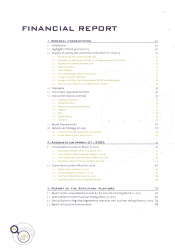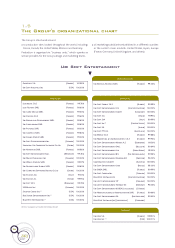Ubisoft 2002 Annual Report Download - page 38
Download and view the complete annual report
Please find page 38 of the 2002 Ubisoft annual report below. You can navigate through the pages in the report by either clicking on the pages listed below, or by using the keyword search tool below to find specific information within the annual report.
2003
38
FINANCIAL
REPORT
1.6.5 Risks
Dependence on sub-contractors,suppliers and customers
The company has no significant dependence on sub-contractors,
suppliers or customers that could affect its development plan.
Ubisoft has two types of distribution networks:
the centralized Anglo-American model (prevalent in the
United States, the United Kingdom and Japan) whereby
products are bought by a chain's buyer and distributed to its
own stores;
the decentralized European model (found in Germany,
France, Switzerland, Benelux, Italy, Spain, etc.) whereby the
chain makes centralized purchases of products, but gets a
distributor to handle delivery to each of its stores.
Ubisoft's 10 largest customers account for 33.5% of the
Group's pre-tax sales.
Dependence on manufacturers: Ubisoft, like all publishers of
console games, purchases game cartridges and media from
console manufacturers. Procurement, therefore, is dependent
on production of the media. For PC games,there is no specific
dependence.
Risks related to the departure of key personnel
The company is organized today in such a way as to minimize
risks related to the departure or extended unavailability of key
employees or managers. A program for safeguarding and
sharing know-how,for example,is currently being implemented
at the company with a view to disseminating and circulating
knowledge within the company. Moreover, the human
resources policy, which is applicable to the entire Group, is
founded on its ability to attract, train, retain and motivate
employees having strong technical and managerial skills .
Risks related to liquidity problems and exchange rate volatility
In recent months, the Euronext market has experienced
considerable price and volume variations that have significantly
affected the market price of shares of a large number of listed
companies.At times,these fluctuations have had nothing to do
with the companies' operating performances. Investors are
advised that these market fluctuations may have an effect on
the company's stock price.
Market risks
As of March 31, 2003, more than 74% of the Group's debt was
comprised of bond liability and fixed rate loans (see part XIII of
the notes on the consolidated balance sheet 2.1.4.3).
Fluctuations in the interest rate market therefore do not
greatly impact the Group.
As regards exchange rate risks, the Group protects its positions
in the main significant currencies (i.e. the US dollar,Canadian
dollar, Pound Sterling and the Australian dollar).
It uses natural covers stemming from transactions in the
opposite direction (i.e. purchase of goods in currencies offset
by royalties originating from subsidiaries in the same currency).
For non-covered balances as well as for non-commercial
transactions (i.e.internal loans in foreign currencies),the parent
establishment borrows in these currencies or sets up forward
sale contracts.
As of March 31, 2003, the company had covered purchases for
forward delivery in the amount of 1.389 million in CAD, and
forward sales in the amount of 37.589 million in GBP,
32.059 million in USD and 2.225 million in AUD.
Finally,as of March 31,2003,the Group held 1,169,733 of its own
shares at an average price of 30.26 for a total gross value of
35.394 million, and 8,838,047 shares of Gameloft valued at
an average price of 0.86 for a total gross value of 7,612 million
(see Parts IV and IX in the notes on the consolidated balance
sheet 2.1.4.3).The value of these assets is likely to vary depending
on fluctuations in securities markets.
Risks relating to future acquisitions and integration of the
companies acquired
The company may undertake transactions in view of external
growth in the medium and/or long term. The company's
strong balance sheet and the level of available capital (resulting
from a bond issue in the amount of 128 million and a syndicated
loan for 98 million) should minimize the risks related to
these transactions.These risks,however,could result in:dilution
of existing shares, the creation of significant long-term debt,
possible losses,the creation of provisions linked to the need to
record goodwill or other intangible assets, or even a negative
impact on profitability.
Moreover, the possible loss of key staff of the target company
must be considered in the risks related to mergers and
acquisitions. Such a loss could have a negative effect on the
sales of the acquired company,its earnings and/or its financial
situation. Ubisoft has nonetheless always demonstrated a
high level of proficiency in the integration of acquisitions.
























